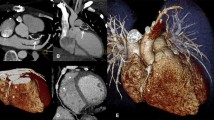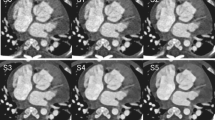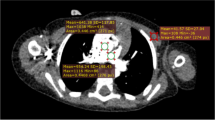Abstract
Background
Dose reduction by combined tube current modulation has not been evaluated in pediatric low-dose CT.
Objective
This study was performed to evaluate tube current reduction in non-ECG-gated heart CT angiography in children by combined tube current modulation, and to assess the effects of body weight, age, sex, and scan direction on tube current reduction.
Materials and methods
From September 2004 to January 2005, non-ECG-gated heart CT examinations were performed with combined tube current modulation in 50 children (median age 1 year, range 1 month to 16 years; M/F 29/21) with congenital heart disease. Sixteen-slice spiral CT studies were obtained using a weight-based low-dose protocol (80 kVp, 50–160 effective mA). CT scans were obtained in the craniocaudal direction when leg veins (n=36) were used for IV injection of contrast agent and in the caudocranial direction when arm veins (n=13) were used. In one child who underwent a Fontan operation, both arm and leg veins were used. We calculated tube current reduction by combined tube current modulation and evaluated the effects of body weight, age, sex, and scan technique on tube current reduction. The quality of CT angiography images was visually evaluated by an experienced pediatric radiologist.
Results
Overall tube current reduction by combined tube current modulation was 15.8±11.1%. The reduction was variable among five body weight groups (9.3±7.9% for <4.9 kg, 14.3±9.3% for 5.0–9.9 kg, 16.4±12.5% for 10.0–19.9 kg, 25.8±9.8% for 20.0–39.9 kg, 15.9±12.7% for 40.0–59.9 kg) and was significantly different among the five groups (P=0.017). When eight children in the 40.0–59.9-kg group were excluded, age showed a significant positive correlation with tube current reduction (γ=0.4, P=0.003). There was no significant difference in tube current reduction between boys and girls. Tube current reduction was significantly greater for the caudocranial scan (21.2±9.2%) than for the craniocaudal scan (14.2±11.3%) (P=0.049). All CT angiography images were of diagnostic quality.
Conclusions
Combined tube current modulation reduced tube current in pediatric non-ECG-gated heart CT by 15.8% without degradation of image quality. With our CT protocol, for body weights up to 39.9 kg, age showed a significant positive correlation with tube current reduction, but there was a lower dose-saving effect in children heavier than 40 kg. Tube current reduction was not affected by sex, but was affected by scan direction.









Similar content being viewed by others
References
Linton OW, Mettler FA Jr (2003) National conference on dose reduction in CT with an emphasis on pediatric patients. AJR 181:321–329
Brenner DJ, Elliston C, Hall E, et al (2001) Estimated risks of radiation-induced fatal cancer from pediatric CT. AJR 176:289–296
Goo HW (2005) Pediatric CT: understanding of radiation dose and optimization of imaging techniques. J Korean Radiol Soc 52:1–5
Kalra MK, Maher MM, Toth TL, et al (2004) Strategies for CT radiation dose optimization. Radiology 230:619–628
Boone JM, Geraghty EM, Seibert JA, et al (2003) Dose reduction in pediatric CT: a rational approach. Radiology 228:352–360
Frush DP, Soden B, Frush KS, et al (2002) Improved pediatric multi-detector body CT using a size-based color-coded format. AJR 178:721–726
Starck G, Lonn L, Cederblad A, et al (2002) A method to obtain the same level of CT image noise for patients of various sizes, to minimize radiation dose. Br J Radiol 75:140–150
Sigal-Cinqualbre AB, Hennequin R, Abada HT, et al (2004) Low-kilovoltage multi-detector row chest CT in adults: feasibility and effect on image quality and iodine dose. Radiology 231:169–174
Kalra MK, Maher MM, Toth TL, et al (2004) Techniques and applications of automatic tube current modulation for CT. Radiology 233:649–657
Flohr TG, Schaller S, Stierstorfer K, et al (2005) Multi-detector row CT systems and image-reconstruction techniques. Radiology 235:756–773
Goo HW, Park IS, Ko JK, et al (2003) CT of congenital heart disease: normal anatomy and typical pathologic conditions. Radiographics 23:S147–S165
Goo HW (2004) Evaluation of the airways in patients with congenital heart disease using multislice CT. J Korean Pediatr Cardiol Soc 8:37–43
Goo HW, Park IS, Ko JK, et al (2005) Computed tomography for the diagnosis of congenital heart disease in pediatric and adult patients. Int J Cardiovasc Imaging 21:347–365
Goo HW, Park IS, Ko JK, et al (2005) Visibility of the origin and proximal course of coronary arteries on non-ECG-gated heart CT in patients with congenital heart disease. Pediatr Radiol 35:792–798
Mulkens TH, Bellinck P, Baeyaert M, et al (2005) Use of an automatic exposure control mechanism for dose optimization in multi-detector CT examinations: clinical evaluation. Radiology 237:213–223
Greess H, Lutze J, Nomayr A, et al (2004) Dose reduction in subsecond multislice spiral CT examination of children by online tube current modulation. Eur Radiol 14:995–999
Greess H, Wolf H, Baum U, et al (2000) Dose reduction in computed tomography by attenuation-based on-line modulation of tube current: evaluation of six anatomical regions. Eur Radiol 10:391–394
Das M, Mahnken AH, Mühlenbruch G, et al (2005) Individually adapted examination protocols for reduction of radiation exposure for 16-MDCT chest examinations. AJR 184:1437–1443
Kalra MK, Rizzo S, Maher MM, et al (2005) Chest CT performed with z-axis modulation: scanning protocol and radiation dose. Radiology 237:303–308
Tack D, De Maertelaer V, Gevenois PA (2003) Dose reduction in multidetector CT using attenuation-based online tube current modulation. AJR 181:331–334
Mastora I, Remy-Jardin M, Delannoy V, et al (2004) Multi-detector row spiral CT angiography of the thoracic outlet: dose reduction with anatomically adapted online tube current modulation and preset dose savings. Radiology 230:116–124
Greess H, Nomayr A, Wolf H, et al (2002) Dose reduction in CT examination of children by an attenuation-based on-line modulation of tube current (CARE Dose). Eur Radiol 12:1571–1576
Rizzo SM, Kalra MK, Schmidt B (2005) Automatic exposure control techniques for individual dose adaptation (letter). Radiology 235:335–336
Menke J (2005) Comparison of different body size parameters for individual dose adaptation in body CT of adults. Radiology 236:565–571
Rizzo SM, Kalra MK, Maher MM, et al (2005) Do metallic endoprostheses increase radiation dose associated with automatic tube-current modulation in abdominal-pelvic MDCT? A phantom and patient study. AJR 184:491–496
Dalal T, Kalra MK, Rizzo SM, et al (2005) Metallic prosthesis: technique to avoid increase in CT radiation dose with automatic tube current modulation in a phantom and patients. Radiology 236:671–675
Author information
Authors and Affiliations
Corresponding author
Additional information
An erratum to this article can be found at http://dx.doi.org/10.1007/s00247-006-0186-2
Rights and permissions
About this article
Cite this article
Goo, H.W., Suh, D.S. Tube current reduction in pediatric non-ECG-gated heart CT by combined tube current modulation. Pediatr Radiol 36, 344–351 (2006). https://doi.org/10.1007/s00247-005-0105-y
Received:
Revised:
Accepted:
Published:
Issue Date:
DOI: https://doi.org/10.1007/s00247-005-0105-y




